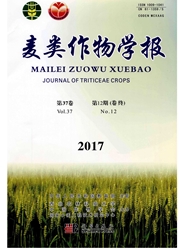

 中文摘要:
中文摘要:
The leaf photosynthesis and nitrogen(N) translocation in three large-spike lines and control cultivar(Xi’nong 979) of winter wheat(Triticum aestivum L.) were studied in 2010–2011 and 2011–2012. The objectives of this study were to investigate the differences in the physiological characteristics of large-spike lines and control cultivar and identify the limiting factors that play a role in improving the yield of breeding materials. The average yield, grain number per spike, kernel weight per spike, and 1 000-kernel weight of the large-spike lines were 16.0, 26.8, 42.6, and 15.4%, respectively, significantly higher than those of control. The average photosynthetic rates(Pn) were not significant between the large-spike lines and control cultivar during the active growth period. The average PSII maximum energy conversion efficiency(Fv/Fm), PSII actual quantum efficiency(ФPSII), photochemical quenching coefficient(qP), PSII reaction center activity(Fv′/Fm′) and water-use efficiency(WUE) of the large-spike lines were 1.0, 5.1, 3.6, 0.8, and 43.4%, respectively, higher than those of the control during the active growth stages. The N distribution proportions in different tissues were ranked in the order of grains>culms+sheathes>rachis+glumes>flag leaves>penultimate leaves>remain leaves. This study suggested that utilization of the large-spike wheat might be a promising approach to obtain higher grain yield in Northwest China.
 英文摘要:
英文摘要:
The leaf photosynthesis and nitrogen(N) translocation in three large-spike lines and control cultivar(Xi'nong 979) of winter wheat(Triticum aestivum L.) were studied in 2010–2011 and 2011–2012. The objectives of this study were to investigate the differences in the physiological characteristics of large-spike lines and control cultivar and identify the limiting factors that play a role in improving the yield of breeding materials. The average yield, grain number per spike, kernel weight per spike, and 1 000-kernel weight of the large-spike lines were 16.0, 26.8, 42.6, and 15.4%, respectively, significantly higher than those of control. The average photosynthetic rates(Pn) were not significant between the large-spike lines and control cultivar during the active growth period. The average PSII maximum energy conversion efficiency(Fv/Fm), PSII actual quantum efficiency(Ф(PSII)), photochemical quenching coefficient(qP), PSII reaction center activity(Fv′/Fm′) and water-use efficiency(WUE) of the large-spike lines were 1.0, 5.1, 3.6, 0.8, and 43.4%, respectively, higher than those of the control during the active growth stages. The N distribution proportions in different tissues were ranked in the order of grains〉culms+sheathes〉rachis+glumes〉flag leaves〉penultimate leaves〉remain leaves. This study suggested that utilization of the large-spike wheat might be a promising approach to obtain higher grain yield in Northwest China.
 同期刊论文项目
同期刊论文项目
 同项目期刊论文
同项目期刊论文
 期刊信息
期刊信息
